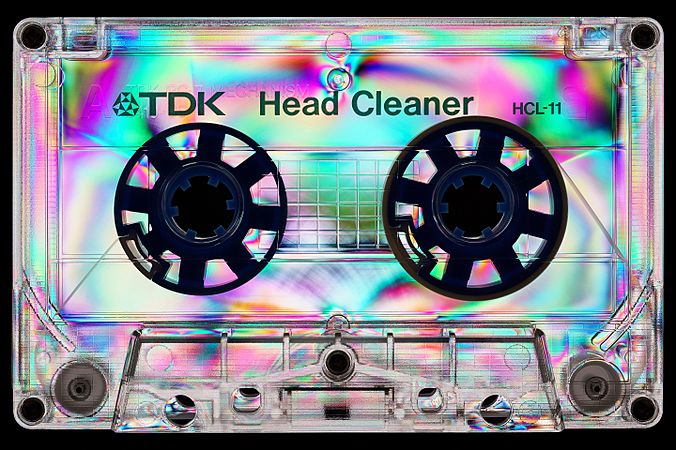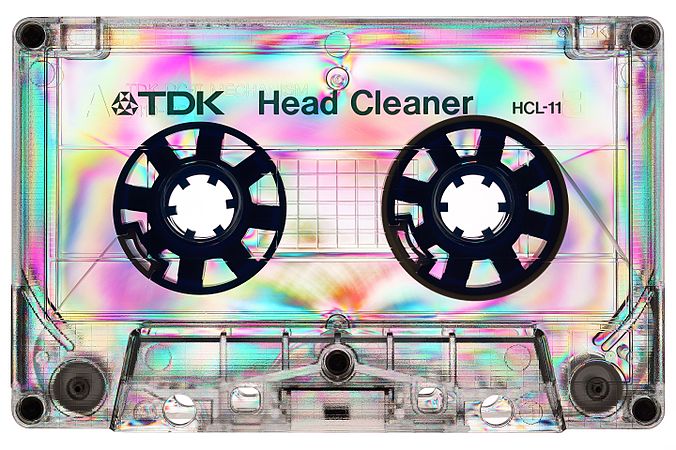Commons:Featured picture candidates/Set/Photoelasticity - TDK Head Cleaner
Jump to navigation
Jump to search
Photoelasticity - TDK Head Cleaner, featured[edit]
Voting period is over. Please don't add any new votes.Voting period ends on 27 Mar 2017 at 15:07:39 (UTC)
-
TDK Head Cleaner - Black background
Polarising filter cancels out direct light from polarised light source -
TDK Head Cleaner - White background
Polarising filter aligned with direct light from polarised light source
 Info Going further back in time than Compact Disc, here is a TDK Head Cleaner. The clear plastic is birefringent and demonstrates internal stress as coloured patterns (photoelasticity) when photographed using cross polarisation. In first photo, the polarising filter on the lens is at right-angles to the polarised light from the LCD monitor behind the cassette. This cancels out all the direct light, producing a black background. In second photo, the monitor was rotated 90°, aligning the polarised light with the filter. This lets through all the direct light, producing a white background. The colours are stronger in the first photo but also switched about (e.g., green and magenta). You can see a Juxtapose of the two images here. For reference, the cassette under normal light is shown in this photo. The pair of images demonstrate how rotation by 90° affects the interaction of polarised light with a polarised filter. All by me. -- Colin (talk) 15:07, 18 March 2017 (UTC)
Info Going further back in time than Compact Disc, here is a TDK Head Cleaner. The clear plastic is birefringent and demonstrates internal stress as coloured patterns (photoelasticity) when photographed using cross polarisation. In first photo, the polarising filter on the lens is at right-angles to the polarised light from the LCD monitor behind the cassette. This cancels out all the direct light, producing a black background. In second photo, the monitor was rotated 90°, aligning the polarised light with the filter. This lets through all the direct light, producing a white background. The colours are stronger in the first photo but also switched about (e.g., green and magenta). You can see a Juxtapose of the two images here. For reference, the cassette under normal light is shown in this photo. The pair of images demonstrate how rotation by 90° affects the interaction of polarised light with a polarised filter. All by me. -- Colin (talk) 15:07, 18 March 2017 (UTC) Support -- Colin (talk) 15:07, 18 March 2017 (UTC)
Support -- Colin (talk) 15:07, 18 March 2017 (UTC) Support What a trip! Reality is overrated. --cart-Talk 15:15, 18 March 2017 (UTC)
Support What a trip! Reality is overrated. --cart-Talk 15:15, 18 March 2017 (UTC) Support out of pure interest, mostly, and also respect for the great focus on the subjects (the one on the left being cooler to me than the other). I'm still not quite sure I understand what you did, though. Did you produce some kind of spectroscopy? -- Ikan Kekek (talk) 15:20, 18 March 2017 (UTC)
Support out of pure interest, mostly, and also respect for the great focus on the subjects (the one on the left being cooler to me than the other). I'm still not quite sure I understand what you did, though. Did you produce some kind of spectroscopy? -- Ikan Kekek (talk) 15:20, 18 March 2017 (UTC)
| More details on the setup/physics |
|---|
|
 Support --Basotxerri (talk) 15:54, 18 March 2017 (UTC)
Support --Basotxerri (talk) 15:54, 18 March 2017 (UTC) Support of course. Colin has become a masterfully skilled expert on turning banal objects into abstract pieces of art. --Martin Falbisoner (talk) 16:09, 18 March 2017 (UTC)
Support of course. Colin has become a masterfully skilled expert on turning banal objects into abstract pieces of art. --Martin Falbisoner (talk) 16:09, 18 March 2017 (UTC) Support Christian Ferrer (talk) 18:45, 18 March 2017 (UTC)
Support Christian Ferrer (talk) 18:45, 18 March 2017 (UTC) Support lNeverCry 18:54, 18 March 2017 (UTC)
Support lNeverCry 18:54, 18 March 2017 (UTC) Support Will never forget the awesome plasticky smell of fresh cassettes. Jm3 (talk) 04:11, 19 March 2017 (UTC)
Support Will never forget the awesome plasticky smell of fresh cassettes. Jm3 (talk) 04:11, 19 March 2017 (UTC) Support Nice! -- Thennicke (talk) 12:57, 19 March 2017 (UTC)
Support Nice! -- Thennicke (talk) 12:57, 19 March 2017 (UTC) Support -- KTC (talk) 19:23, 19 March 2017 (UTC)
Support -- KTC (talk) 19:23, 19 March 2017 (UTC) Support Groovy! Daniel Case (talk) 01:27, 20 March 2017 (UTC)
Support Groovy! Daniel Case (talk) 01:27, 20 March 2017 (UTC) Support Wow! Jacopo Werther iγ∂ψ=mψ 19:17, 21 March 2017 (UTC)
Support Wow! Jacopo Werther iγ∂ψ=mψ 19:17, 21 March 2017 (UTC)
Confirmed results:
This image will be added to the FP gallery: Objects

